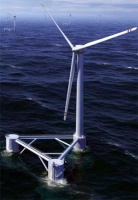Floating platform for ocean-based wind turbines
Wind turbines may be one of the best renewable energy solutions, but as turbines get larger they also get noisier, become more of an eyesore, and require increasingly larger expanses of land.

One solution is ocean-based wind turbines, and while these have already been erected, they have traditionally been situated in shallow waters, where the tower extends directly into the seabed. That restricts the turbines to near-shore waters with depths no greater than 50m and precludes their use in deeper waters, where winds generally gust at higher speeds.
An alternative is placing turbines on floating platforms, said naval architect Dominique Roddier of Berkeley, California-based Marine Innovation & Technology.
He and his and colleagues have published a feasibility study of one platform design — dubbed WindFloat — in the latest issue of the Journal of Renewable and Sustainable Energy, which is published by the American Institute of Physics (AIP).

By testing a 1:65 scale model in a wave tank, the researchers showed that the three-legged floating platform, which is based on existing gas and oil offshore platform designs, is stable enough to support a 5MW wind turbine, the largest turbine that currently exists.
Register now to continue reading
Thanks for visiting The Engineer. You’ve now reached your monthly limit of news stories. Register for free to unlock unlimited access to all of our news coverage, as well as premium content including opinion, in-depth features and special reports.
Benefits of registering
-
In-depth insights and coverage of key emerging trends
-
Unrestricted access to special reports throughout the year
-
Daily technology news delivered straight to your inbox










National Gas receives funding to develop Gravitricity underground hydrogen storage system
There can't possibly ever be a '<i>business</i>' case for the <i><b>bulk</b></i> storage of hydrogen, since Green hydrogen electrolysis...